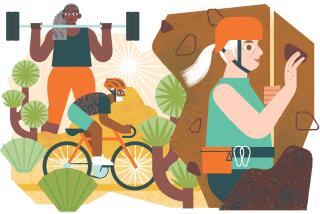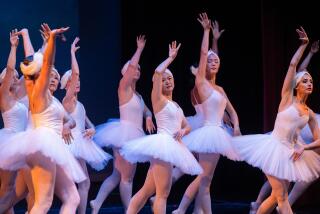Quick, somebody call Bianca! Disco’s back
- Share via
Once, I loved circuit training, moving from machine to machine, inspecting and admiring the rippling muscles in the mirror -- they weren’t my muscles, but I appreciated them anyway.
Eventually I moved on to other forms of exercise, but I never got over my affection for those bright, shiny machines. So when I heard about the Sports Club/LA’s “themed loop” circuit training classes, I was there.
That partly explains how, a few weeks back, I came to be sheepishly shake-shake-shaking my booty to K.C. and the Sunshine Band while inside a whooping, hollering circle of disco dancers.
But first things first. Straight, no-frills circuit training (clambering onto a series of exercise machines to get a full body workout) was introduced in the early 1950s at the University of Leeds in England, as a time-efficient strengthening regimen. Its popularity grew in the 1970s with the invention of the Nautilus machine, and was in full swing by the 1980s.
The downside of circuit training is that even though the machines may never lose their luster, the endless repetitions do.
Fitness clubs are aware of the issue of workout boredom and are constantly introducing new gadgets, props and methods to liven up old routines. Some of these new offerings include strength-, tone- and balance-enhancing gadgets such as fitness balls, body bars, gliding discs and even Hula Hoops.
One such addition is the Sports Club/LA’s themed loop training classes. Introduced last year, they incorporate specialized music or high-octane activities into standard circuit training. In the club’s boot camp loop, for example, participants go through the circuit, then a drill sergeant-instructor tells everyone to dismount and barks out orders to drop and give him 20. Survivors of the class report it has everything but early morning reveille.
I picked up a copy of the club’s loop schedule and considered the possibilities. Boot camp -- negatory. I don’t respond well to authority. Comedy loop at 6 a.m.? You must be joking.
Disco ... disco! Training to the groovy tunes of the Bee Gees and Donna Summer. I could just picture it. We would step back to a time when polyester was king and colorful flashing lights didn’t mean “pull over!”
The disco loop class is held on Thursday afternoons in the club’s circuit training room. When I arrived, fitness instructor Troy Todd was setting up his bongo drums and arranging the machines in a large circle. About a dozen members filtered in. The group, mostly women and ranging in age from 20s to 60s, was friendly and talkative. Todd explained that we would go from machine to machine, and overhead lights would flash blue and red when it was time to move to the next one. When we finished a complete circuit, we would get up and bust a few moves.
In short, there would be dancing.
Dancing. It was the one nagging concern I’d had when signing up for this class. I’m a horrible dancer. Not just bad, but a truly rip-your-hair-out-awful dancer. It was too late to turn back. But I would stand in the back and blend.
As I was chewing on this new development, Todd cued up “Freak Out,” and we were off.
Each person settled at one of 12 exercise machines while Todd went around the room adjusting weights and correcting posture. I was just starting to get the hang of my machine, pulling the overhead bar down smartly to my shoulders, when Todd pointed out that I was facing in the wrong direction. Oops.
Just as I was settled into proper form, the lights flashed, and we all hopped up and moved to the next machine.
Fueled by, yes, K.C. and the Sunshine Band -- “Get Down Tonight” -- we continued like this for several minutes: a few bicep curls (“Do a little dance, make a little love”) -- on to the next station. A few leg extensions (“Get down tonight, get down tonight”) -- on to free weights.
About 15 minutes later, we’d come full circle -- sweaty but pumped and humming to the music. Todd called out “Stop!” and directed us to form a ring. The music switched to the Commodores’ ode to womanhood, “Brickhouse.” Todd directed us to do a little line-dance shuffle, two steps in, two steps out.
Then he stopped suddenly, narrowed his eyes and looked around the circle like a tiger seeking out his prey. He reached both arms out and motioned like a snake charmer to his victim. It was the dreaded “call out.”
An incredibly buff woman, whom I later found out was a grandmother, launched herself into the circle, strutting her stuff like a “Solid Gold” dancer. She spun around, arms waving overhead, then danced back, rejoining the line. The class cheered.
With Summer singing “Dim the Lights,” Todd continued motioning participants into the circle. Some were shy, doing a little step, then scurrying back into line. Others flailed with abandon.
When my number was up I did my best, shuffling forward, bent over, feet stamping awkwardly in a desperate rain dance. It was bad, but my Cherokee ancestors would have been proud.
Todd, to be fair, was careful not to embarrass participants. “If I see that someone’s shy,” he said later, “I pair them with someone else so they’re not dancing alone.”
He next divided us into two lines, facing each other as if at a square dance. It was the familiar Soul Train lineup from “Saturday Night Fever.”
As pairs of dancers took their turn to prance down the cheering gantlet, some channeled the spirit of John Travolta’s Tony Manero -- slithering down the aisle wagging one index finger at the sky -- while others howled with mortification. By then, we were getting an excellent aerobic workout, but at a price: There was no hiding.
After the dance sequence, Todd directed us back to the machines for another circuit, which got my muscles burning, followed by more dancing. Next time, I noticed, it was a little less intimidating.
By the end, the class’ whooping had attracted a slew of spectators outside the room, noses pressed against the window.
Judith Holtz was one of the participants. She began coming to the club last year following knee surgery, and took the class to keep her workouts interesting.
Holtz has tried several of the loop classes, including boot camp and ‘70s funk, and likes them all, especially disco. “I love it,” she said. “I love the dancing.”
Most of the people I spoke with afterward said something similar. “The most important part of doing this exercise is having a sense of humor,” said Holtz, “and not taking yourself too seriously.”
Right on. Plus, for someone muscle-challenged like me, this was a great workout.
They say that if you can remember a fad the first time around, you probably shouldn’t be doing it the next time around, but I’m not sure I agree.
Back in the ‘70s, I was too shy to dance. Having accepted the notion that embarrassment is character building, I’m ready to get out there, jump on a machine -- the right way -- and boogie oogie oogie till I just can’t boogie no more.


